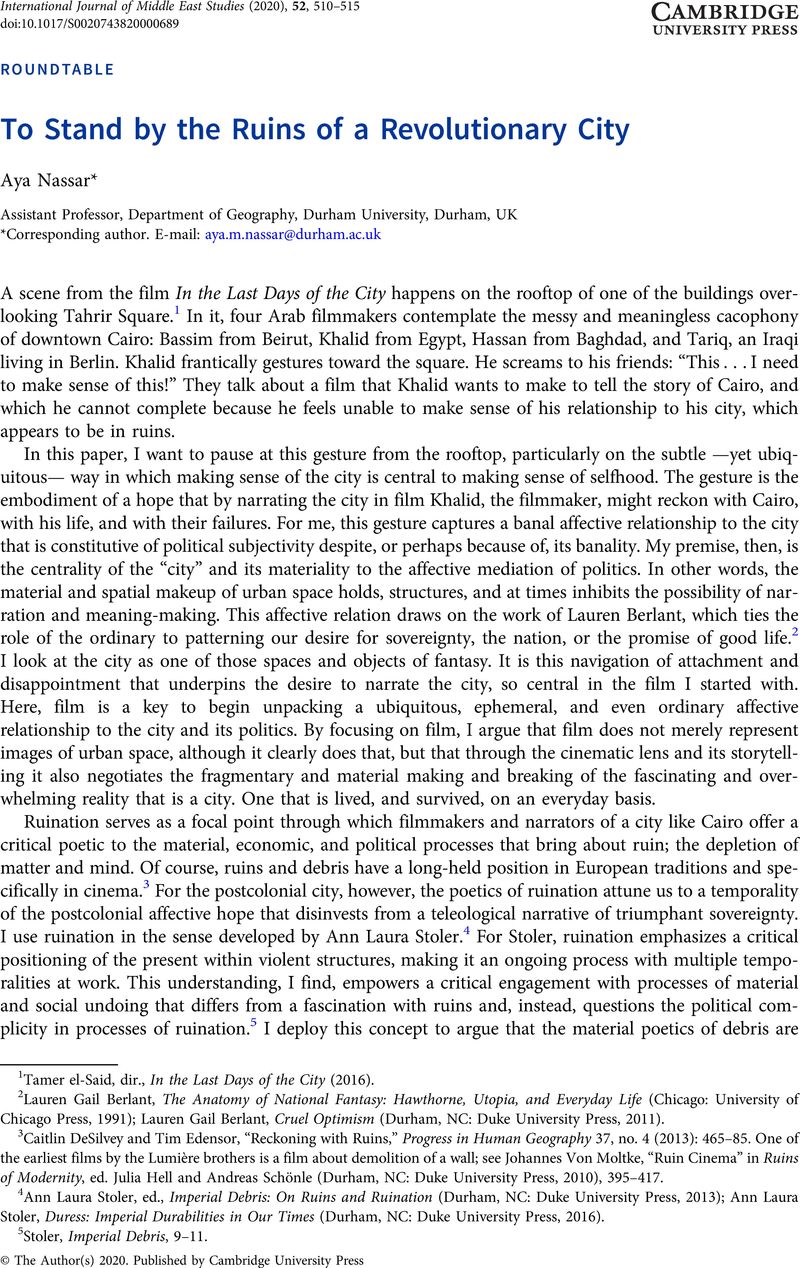Published online by Cambridge University Press: 07 September 2020

1 Tamer el-Said, dir., In the Last Days of the City (2016).
2 Berlant, Lauren Gail, The Anatomy of National Fantasy: Hawthorne, Utopia, and Everyday Life (Chicago: University of Chicago Press, 1991)Google Scholar; Berlant, Lauren Gail, Cruel Optimism (Durham, NC: Duke University Press, 2011)CrossRefGoogle Scholar.
3 DeSilvey, Caitlin and Edensor, Tim, “Reckoning with Ruins,” Progress in Human Geography 37, no. 4 (2013): 465–85CrossRefGoogle Scholar. One of the earliest films by the Lumière brothers is a film about demolition of a wall; see Moltke, Johannes Von, “Ruin Cinema” in Ruins of Modernity, ed. Hell, Julia and Schönle, Andreas (Durham, NC: Duke University Press, 2010), 395–417Google Scholar.
4 Stoler, Ann Laura, ed., Imperial Debris: On Ruins and Ruination (Durham, NC: Duke University Press, 2013)CrossRefGoogle Scholar; Stoler, Ann Laura, Duress: Imperial Durabilities in Our Times (Durham, NC: Duke University Press, 2016)CrossRefGoogle Scholar.
5 Stoler, Imperial Debris, 9–11.
6 See Gordon, Joel, Revolutionary Melodrama: Popular Film and Civic Identity in Nasser's Egypt (Chicago: Middle East Documentation Center, 2002)Google Scholar; and Paul Sedra, “Anxiety about the Urban in 1950s Egyptian Cinema; Q&K,” American University in Cairo, 2015, https://www.youtube.com/watch?v=KiQTadPKjiU.
7 Aya Nassar, “Spaces of Power: Politics, Subjectivity and Materiality in Post-Independence Cairo” (PhD thesis, University of Warwick, 2019). See also Volait, Mercedes, L'architecture moderne en Égypte et la revue al-’Imara 1939–1959 (Cairo: CEDEJ Égypte/Soudan, 1988)CrossRefGoogle Scholar, http:///books.openedition.org/cedej/870; Moore, Clement Henry, Images of Development: Egyptian Engineers in Search of Industry, 2nd ed. (Cairo: American University in Cairo Press, 1994)Google Scholar; and Mohamed Elshahed, “Revolutionary Modernism? Architecture and the Politics of Transition in Egypt 1936–1967” (PhD diss., New York University, 2015).
8 For instance, see el-Shakry, Omnia, “Cairo as Capital of Socialist Revolution?” in Cairo Cosmopolitan: Politics, Culture, and Urban Space in the New Globalized Middle East, ed. Singerman, Diane and Amar, Paul (Cairo: American University in Cairo Press, 2006), 73–98Google Scholar; Alia Mossallam, “Hikayat Sha‛b: Stories of Peoplehood; Nasserism, Popular Politics and Songs in Egypt, 1956–1973” (PhD thesis, London School of Economics and Political Science, 2012); and Reynolds, Nancy Y., “City of the High Dam: Aswan and the Promise of Postcolonialism in Egypt,” City & Society 29, no. 1 (2017): 213–35CrossRefGoogle Scholar.
9 Kassab, Elizabeth Suzanne, Contemporary Arab Thought: Cultural Critique in Comparative Perspective (New York: Columbia University Press, 2010)Google Scholar; Di-Capua, Yoav, “The Traumatic Subjectivity of Sun‘ Allah Ibrahim's Dhat,” Journal of Arabic Literature 43, no. 1 (2012): 80–101CrossRefGoogle Scholar; Dawisha, Adeed I., Arab Nationalism in the Twentieth Century: From Triumph to Despair, 2nd ed. (Princeton, NJ: Princeton University Press, 2016), 282Google Scholar.
10 Zakariya, Essam, Atyaf al-Hadatha: Suwar Misr al-Ijtima‘iyya fi al-Sinima (Cairo: al-Majlis al-Aʿla li-l-Thaqafa, 2009), 79–86Google Scholar; Shafik, Viola, Arab Cinema: History and Cultural Identity(Cairo: American University in Cairo Press, 2016), 286Google Scholar.
11 For a discussion of documentaries and global audiences see, for example, Alia Ayman, “Three Films, One Spectator and A Polemic: Arab Documentaries and ‘Global’ Audiences,” 2016, http://www.jadaliyya.com/pages/index/25763/three-films-one-spectator-and-a-polemic_arab-docum; and Alisa Lebow, “Filming Revolution,” Stanford University, 2018, https://filmingrevolution.org.
12 Shafik, Arab Cinema, 56–57, 227.
13 See Muhammad El-Hajj's statement in this issue.
14 Scott, David, “The Tragic Vision in Postcolonial Time,” PMLA 129, no. 4 (2014): 799–808CrossRefGoogle Scholar.
15 Berlant, Lauren Gail, “The Commons: Infrastructures for Troubling Times,” Environment and Planning D: Society and Space 34, no. 3 (2016): 395CrossRefGoogle Scholar.
16 Ibid.
17 Last, Angela, “We Are the World? Anthropocene Cultural Production between Geopoetics and Geopolitics,” Theory, Culture & Society 34, no. 2–3 (2017): 151CrossRefGoogle Scholar.
18 Jay Weissberg, “Berlin Film Review: In the Last Days of the City,” Variety, 14 February 2016, http://variety.com/2016/film/festivals/in-the-last-days-of-the-city-review-berlin-film-festival-1201705591/.
19 The cacophony of Cairo has been the subject of an earlier film with a psychological take on the fear of the city. The Aquarium (dir. Yousry Nasrallah, 2008) features similar takes on traffic jams and the carnival of lights as brake lights mingle with dysfunctional traffic lights, all drenched in the soundscapes of the radio. See el-Shakry, Omnia, “‘A Radioscopy of the Egyptian Soul’: Yousry Nasrallah's The Aquarium,” Middle East Journal of Culture and Communication 1, no. 2 (2008): 216–18CrossRefGoogle Scholar.
20 Julia Elyachar writes about an anthropology of learning to walk anew in Cairo in “The Political Economy of Movement and Gesture in Cairo,” Journal of the Royal Anthropological Institute 17, no. 1 (2011): 82–99Google Scholar.
21 Gastón Gordillo, “Resonance and the Egyptian Revolution,” Space and Politics (blog), 6 February 2011, https://criticallegalthinking.com/2011/02/22/resonance-and-the-egyptian-revolution/.
22 See David Scott, Conscripts of Modernity: The Tragedy of Colonial Enlightenment (Durham, NC: Duke University Press, 2004); and Berlant, “The Commons.”
23 Rowan el-Shimi, “12 Viewers on In the Last Days of the City and Its Problems Coming to Egypt,” Mada, 29 March 2017, https://madamasr.com/en/2017/03/29/feature/culture/12-viewers-on-in-the-last-days-of-the-city-and-its-problems-coming-to-egypt/.
24 Ibid.
25 Dixon, Deborah P., Feminist Geopolitics: Material States, Gender, Space and Society (Burlington, VT: Ashgate, 2015)Google Scholar.
26 El-Shimi, “12 Viewers.”
27 el-Kadi, Galila and el-Kerdani, Dalila, “Belle-Époque Cairo: The Politics of Refurbishing the Downtown Business District,” in Cairo Cosmopolitan: Politics, Culture, and Urban Space in the New Globalized Middle East, ed. Singerman, Diane and Amar, Paul (Cairo: American University in Cairo Press, 2006), 345–71Google Scholar.
28 Asef Bayat, “Revolution and Despair,” Mada, 25 January 2015, https://madamasr.com/en/2015/01/25/opinion/u/revolution-and-despair/.
29 Last, “We Are the World?” 160.